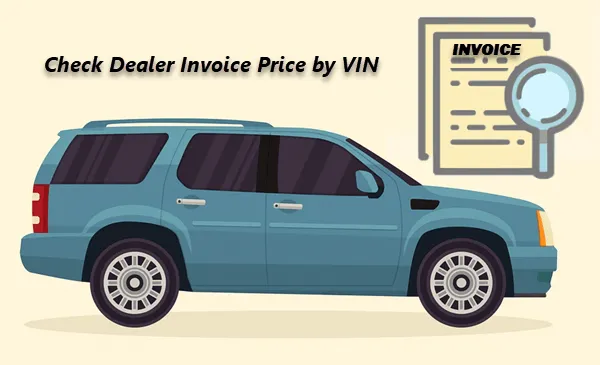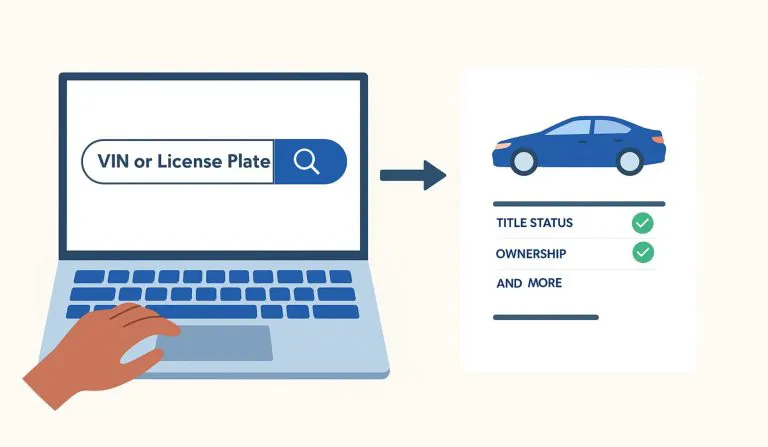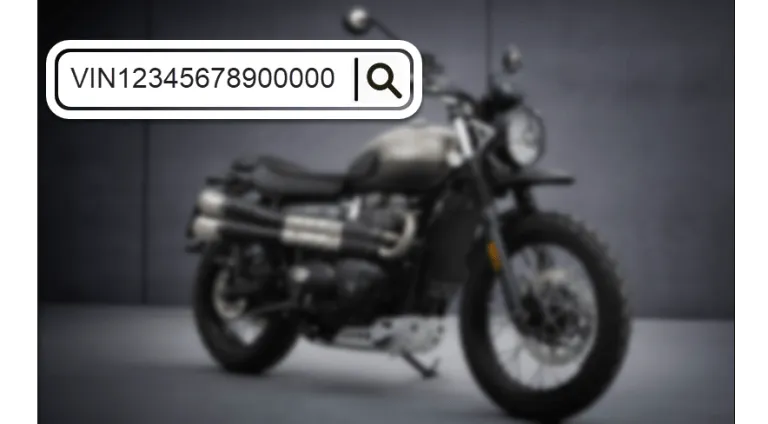What is VIN, How to Decode a VIN & Run a VIN Lookup (2025)
VIN basics: What is a VIN, how to decode it, how to run a VIN, plus how VINs have developed over time
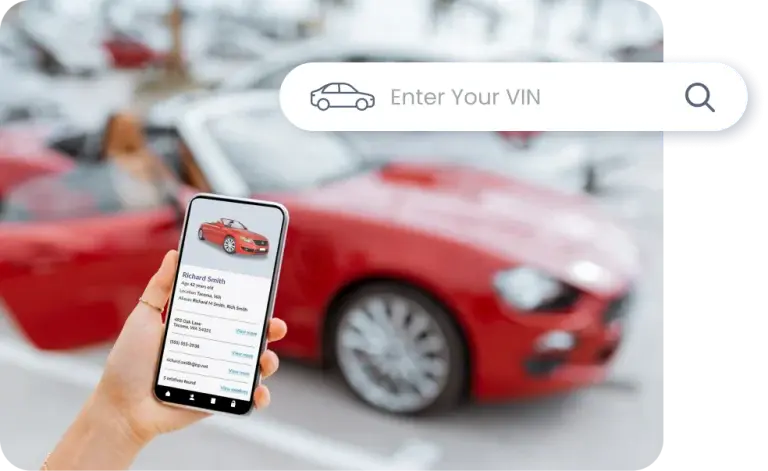
Whether you’re buying a used car, filing an insurance claim, or ordering parts, you’ll likely come across the term VIN. But what is it, and why does it matter?
In this article, we will break down the basics of VINs, show you how to decode a VIN, and explain how a VIN lookup helps reveal a car’s past. Plus, we’ll explain why VINs are 17 digits long — and what it means if yours isn’t. Let’s dive in!
Table of Contents
What is a VIN
VIN stands for Vehicle Identification Number1. Depending on the region, it may also be referred to as a chassis number, frame number, or body number.
The concept of VINs dates back to the 1950s, but it wasn’t until 1981 that a standardized 17-character format was mandated for all vehicles. A modern VIN is a 17-character, alphanumeric code assigned to every vehicle2 at the time of manufacture. As the automotive equivalent of your ID or SSN, a VIN is unique – no two vehicles in the world share the same VIN. While the concept of VINs dates back to the 1950s, it wasn’t until 1981 that the current 17-digit standard was introduced to unify the format across all manufacturers.
What is a VIN used for
Since the VIN remains with a vehicle throughout its entire lifespan, it holds key information and helps track the vehicle’s legal, technical, and administrative history.
Here’s how a VIN is commonly used:
- Buying or selling: Confirms the car’s true identity, matching features, specs, and history with what’s being advertised or listed.
- Vehicle registration: Required by DMVs and other authorities to complete ownership transfers and legal documentation.
- Recalls and safety notices: Manufacturers and safety regulators use VINs to issue vehicle-specific alerts about defects or required repairs.
- Vehicle history checks: A VIN lookup reveals accident history, ownership changes, mileage issues, and more, which is an important step for used cars.
- Insurance: Insurance companies use the VIN to assess risk, confirm coverage, and verify the vehicle in claims and policies.
- Parts ordering: Ensures mechanics and parts suppliers get exact-fit replacements for your vehicle’s make, model, and trim.
- Theft and fraud prevention: Law enforcement can use the VIN to track stolen vehicles, detect tampering, or identify cloned cars.
Can you get personal information from a VIN number?
Yes and no.
A VIN itself doesn’t directly reveal a car owner’s personal information—like name, address, or contact details. Most parts of the VIN tell you things about the vehicle itself, including manufacturer, model, year, and features. However, because your VIN is tied to official documents like registration and insurance, it’s theoretically possible (with access to restricted databases) for someone to trace it back to an individual.
That said, privacy laws—like the Driver’s Privacy Protection Act (DPPA) in the U.S.—protect personal data from being accessed through public VIN searches. Most legitimate VIN lookups only show vehicle-related info, not owner identities.
VIN vs. License Plate Number: What’s the difference?
A VIN is a permanent, globally unique code assigned by the manufacturer that never changes — it tracks a vehicle’s identity, specs, and full history over the course of its life.
A license plate number, on the other hand, is issued by a government authority (such as a state DMV) when a vehicle is registered. Unlike the VIN, it can change — for example, when the car is sold, re-registered in another state, or if the owner requests a custom plate. License plates are primarily used for legal identification, tolling, and law enforcement, but they don’t provide manufacturing or technical data.
In short: the VIN is permanent and tied to the vehicle’s build and history, while the license plate is temporary and tied to the vehicle’s registration status.
Where to find your VIN
There isn’t a single fixed location for the VIN on every vehicle, as placement can vary slightly by manufacturer and model. Still, VINs are required to appear in certain visible and accessible areas — both on the vehicle and in its accompanying paperwork:
1) On the vehicle:
The VIN is usually stamped or printed in several locations on the car’s body for identification and verification purposes. Common places to look include:
- Front of the engine block: Stamped directly onto the metal of the engine.
- Driver’s side dashboard: Easily visible through the windshield from outside the vehicle, near where the dashboard meets the windshield.
- On the inside of the driver’s door: On the inner edge or door jamb, often paired with manufacturing data.
- Driver’s side door post (B-pillar): Often on a sticker or metal plate visible when the door is open.
- Rear wheel well (above the tire): Less common, but occasionally used.
- Under the spare tire in the trunk: Lift the tire to check for a stamped plate or sticker.
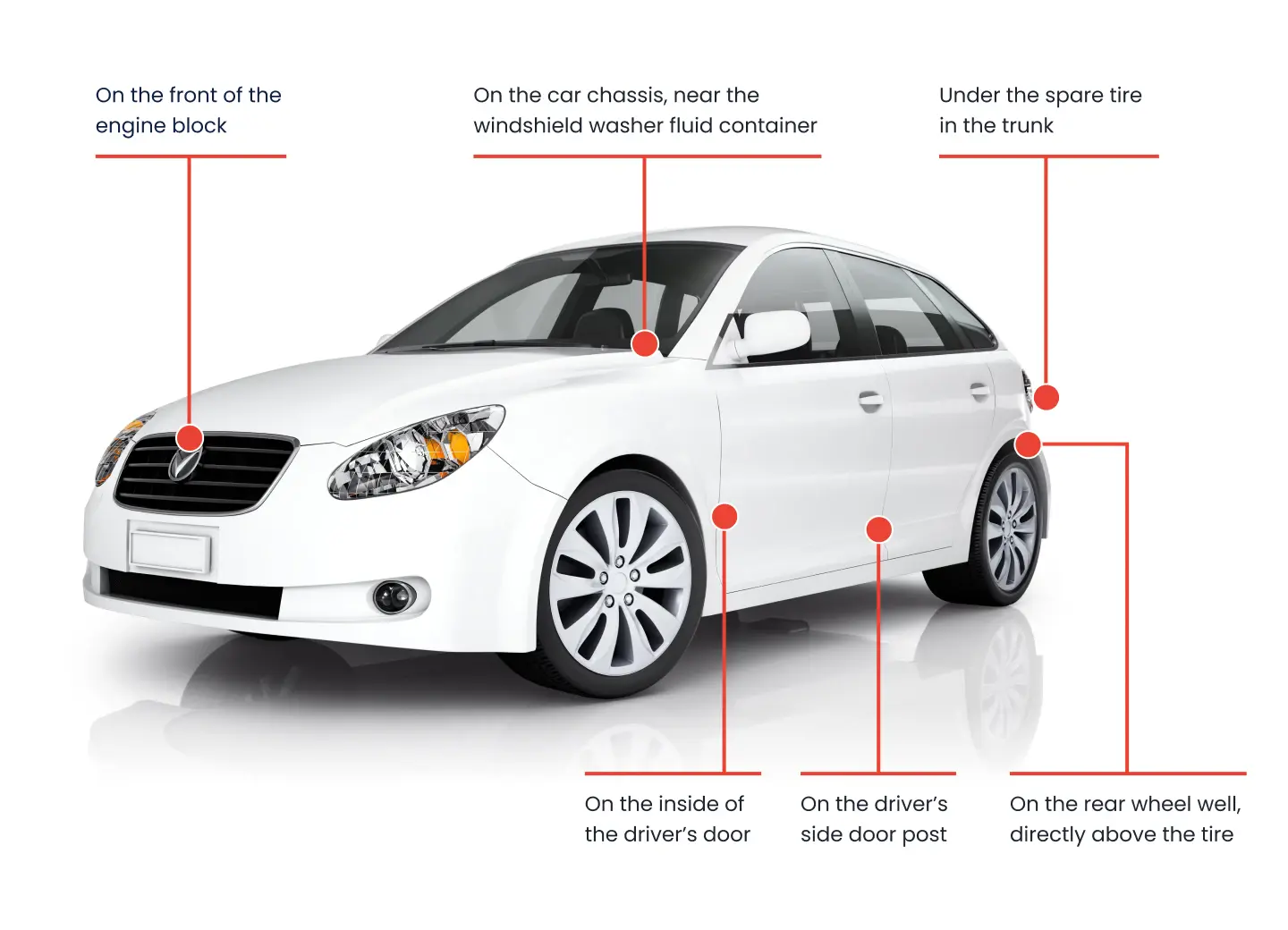
Note: Some vehicles even have the VIN etched3 on windows as an anti-theft measure.
2) On paperwork (in case you want to find the VIN without the vehicle):
- Vehicle title
- Registration documents
- Insurance card or policy
- Ownership certificate or permit
- Build sheet (often available for new or custom vehicles)
- Service and maintenance records
- Emission or inspection certificates
- Financing or loan documents
💡 Tip: Always double-check that the VIN matches across all these places. Mismatched numbers are a major red flag and could indicate tampering or VIN cloning.
Decoding a VIN: Explore a car’s specs & origin
A VIN may look like a jumble of letters and numbers, but it’s actually a carefully structured code that reveals important details about your vehicle’s origin and features. So, what is a VIN composed of?
Like we touched on earlier, a VIN is 17 characters long. But it certainly isn’t a random string. Instead, it’s governed by international standards, specifically ISO 3779:20094 and ISO 4030:19835 —and is used worldwide to uniquely identify every motor vehicle. This global system helps keep things consistent across countries and manufacturers.
To avoid confusion with similar-looking characters, letters I, O, and Q are intentionally excluded because they resemble 1 and 0.
How to decode a VIN
A VIN is divided into three groups:
1. World Manufacturer Identifier (WMI): Characters 1–3
These first three characters identify the vehicle’s manufacturer and where the vehicle was built.
- 1st character: Indicates the country or region of origin, or where the vehicle was assembled. For example, “1” stands for the U.S., “J” for Japan, and “W” for Germany.
- 2nd character: Represents the manufacturer. Combined with the first character, this narrows down the make of the vehicle (e.g., “1G” = General Motors USA).
- 3rd character: Identifies the vehicle type or manufacturing division. This could distinguish between a passenger car and a truck under the same brand.
2. Vehicle Descriptor Section (VDS): Characters 4–9
This section describes the vehicle’s general attributes and includes a key integrity check.
- 4th to 8th characters: Define the model, body style, engine type, transmission, and restraint system. These characters vary depending on the manufacturer but provide essential specs for identification.
- 9th character: Known as the check digit, this is a mathematically generated value that helps verify the authenticity of the VIN. It’s calculated using a specific formula that applies weights to each character. If the result is 10, the digit is shown as “X”6.
3. Vehicle Identifier Section (VIS): Characters 10–17
This portion uniquely identifies the individual vehicle.
- 10th character: Indicates the model year. Letters and digits are used in a repeating cycle (e.g., “A” = 1980, “Y” = 2000, “1” = 2001, etc.).
- 11th character: Tells you the plant where the vehicle was manufactured. This code varies by manufacturer.
- 12th to 17th characters: These are the vehicle’s serial number, which differentiates it from every other car made by the same manufacturer in that year and plant.
🔍 To put it in context, here we use a sample VIN: 1GCDK23LXFS100001.
| Characters | What They Represent | Example Value | Meaning |
|---|---|---|---|
| 1 | Country of origin | 1 | United States |
| 2–3 | Manufacturer | GC | General Motors (Chevrolet division) |
| 4–8 | Vehicle attributes | DK23L | Silverado 2500, extended cab, 4WD, 6.0L V8 |
| 9 | Check digit | X | Check digit |
| 10 | Model year | F | 1985 (based on VIN year chart) |
| 11 | Assembly plant | S | St. Louis, MO |
| 12–17 | Serial number (unique to the vehicle) | 100001 | Production sequence number |
Read more: How to Decode a VIN: What Every Digit Means
Super Easy VIN Decoder
As you can see, every character in a VIN tells a story — but you don’t always have to decode it manually. Unless you’re into piecing together alphanumeric puzzles, you can use Super Easy VIN Decoder to instantly break down any VIN and uncover detailed info about the car’s specs, origin, and more — in just seconds.
- Go to Super Easy VIN Decoder.
- Type or paste the full VIN into the search bar and hit Decode.

- In seconds, you’ll get an overview of the vehicle’s key information, including:
- Basic Info – Make, model, year, body type, etc.
- Engine Details – Engine size, fuel type, cylinders, and performance specs.
- Safety Systems – Airbags, seatbelt configurations, and advanced safety features.
- Exterior Features – Color, lights, mirrors, wheels, and more.
- Interior Features – Seating materials, infotainment system, and comfort options.
- Mechanical Specs – Drivetrain, transmission, suspension, and brakes.
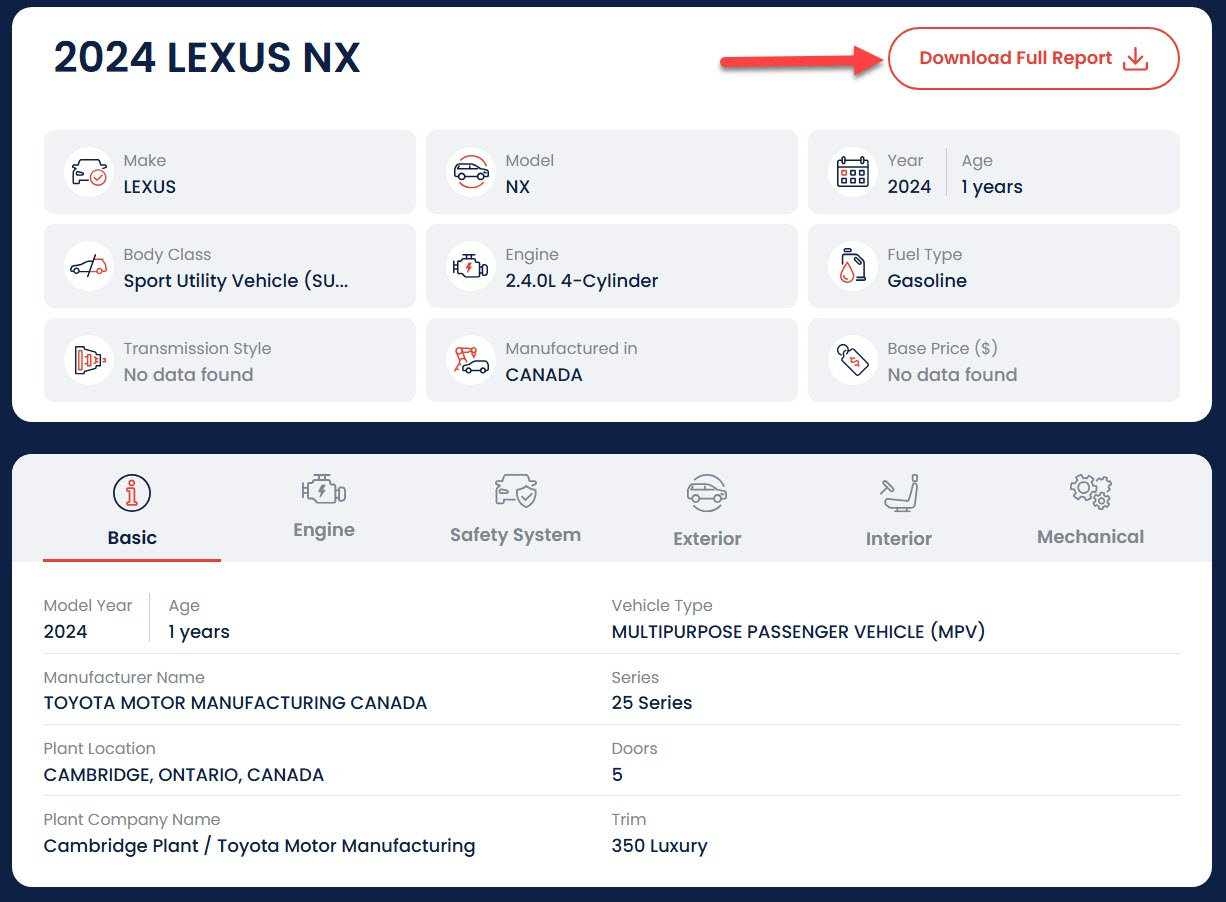
VIN Lookup: Reveal a car’s past
Decoding a VIN gives you a solid snapshot of the vehicle’s build, like engine size, factory-installed features, and where it was assembled. But if you want to know what happened after it left the factory, you should run a VIN lookup.
A VIN lookup goes beyond the build sheet. It pulls together records from multiple databases to uncover the car’s backstory — things like title status, accident history, ownership changes, open recalls, and more. This helps you spot costly red flags early, which is crucial when buying a used car or checking a vehicle’s background before insuring or financing.
Free VIN lookup options
1. NICB (National Insurance Crime Bureau)
The NICB is a nonprofit organization that works with insurers and law enforcement to combat vehicle-related crime. Its VIN Check tool allows you see if a vehicle has been reported stolen or declared a total loss by an insurance company.
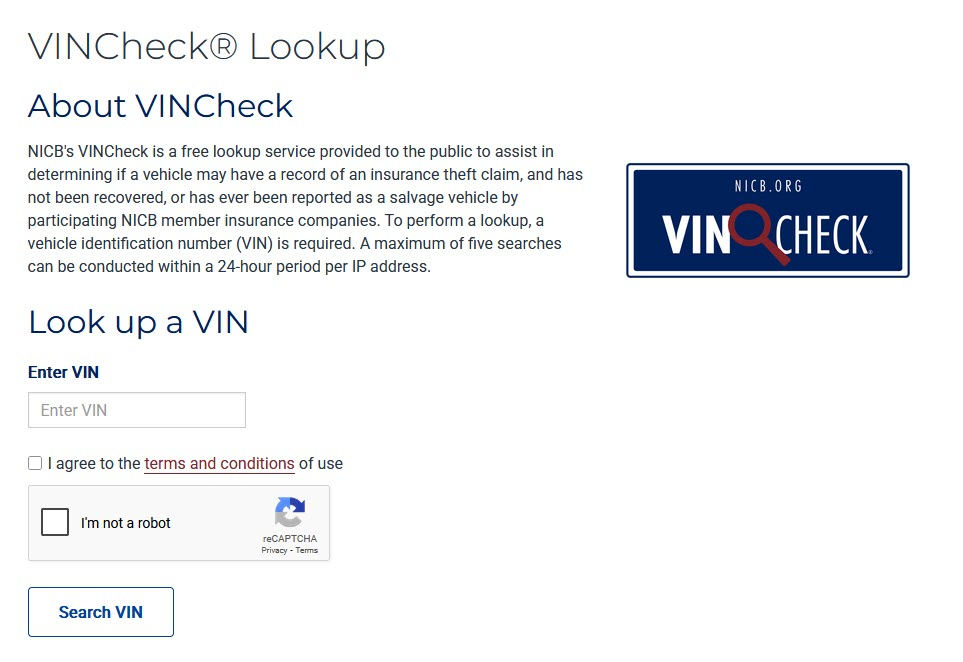
Checking with NICB is a good first step to flag major issues, especially when buying from a private seller. But the information is pretty bare-bones — you won’t see accident history or ownership changes.
2. NHTSA (National Highway Traffic Safety Administration)
A federal agency under the U.S. Department of Transportation, the NHTSA is responsible for vehicle safety standards and recall enforcement. They offer a free VIN lookup tool to check for recalls linked to a specific VIN. Just enter the VIN, and it will show any open or past recalls that haven’t been addressed. It’s simple and trustworthy, but doesn’t tell you anything about ownership history, accidents, or title issues.
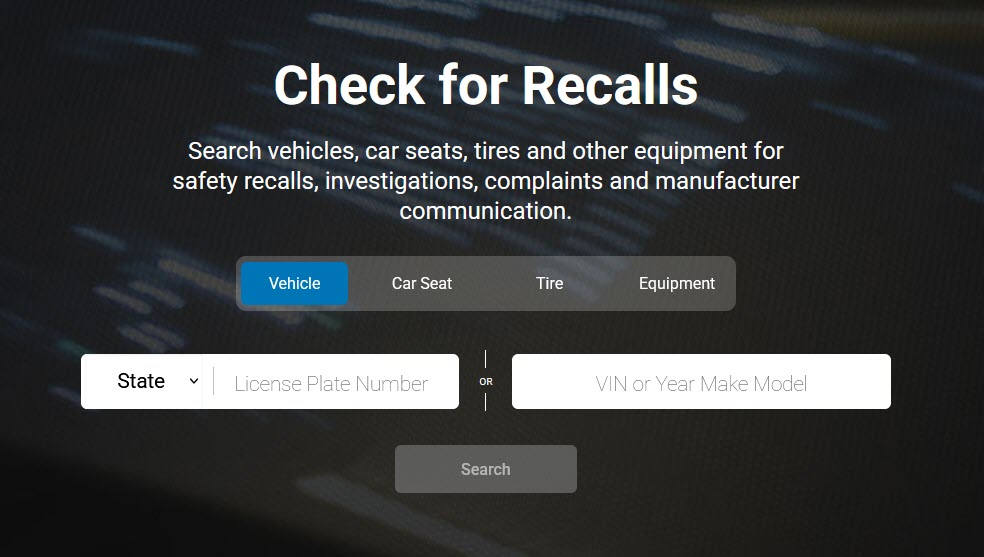
💡 Tip: NHTSA doesn’t just offer a recall lookup tool — it also provides a VIN decoder that reveals detailed, factory-reported specs, including safety systems like ABS, ESC, and TPMS. This can help verify whether a vehicle is built as advertised.
3. State DMV websites
Some state DMVs offer VIN-based title and lien searches, but access is usually restricted to vehicle owners or authorized parties who can provide proof of ownership or legal interest. While a few states may allow limited basic information to be checked by the public, most detailed title and lien records require formal requests, identification, and sometimes a fee. Because of these restrictions, casual users often cannot simply enter any VIN online to get a detailed vehicle history from DMV databases.
Why free tools might not be enough
Each of the above tools serves a specific purpose, but none of them paint the full picture on their own. That’s because VIN data is scattered across a wide range of sources, including government agencies, insurance companies, DMVs, repair shops, and salvage yards. If you want a more complete look at a vehicle’s background, you’ll need to tap into a broader, centralized database — NMVTIS.
What Is NMVTIS?
The National Motor Vehicle Title Information System (NMVTIS) is a federally mandated database designed to prevent title fraud, reduce stolen vehicle resale, and protect consumers from unsafe or previously totaled vehicles.
It pulls information from:
- State motor vehicle titling agencies
- Insurance carriers
- Salvage yards and junkyards
- Auto recyclers
This data gives a more structured, nationwide view of a vehicle’s title status, salvage history, and odometer readings. However, NMVTIS is not directly accessible to the public. Instead, it authorizes approved providers to deliver the data to consumers. Among these, we recommend Bumper and Carfax as reliable options for thorough vehicle history reports:
1. Bumper
Bumper is one such NMVTIS-approved provider. Built for everyday consumers, it compiles vehicle information from NMVTIS, JD Power, NHTSA, dealerships, insurance carriers, and many other trusted agencies.
Running a VIN lookup with Bumper is pretty easy. All you need to do is go to Bumper VIN Lookup, enter the VIN of your vehicle, and hit SEARCH:
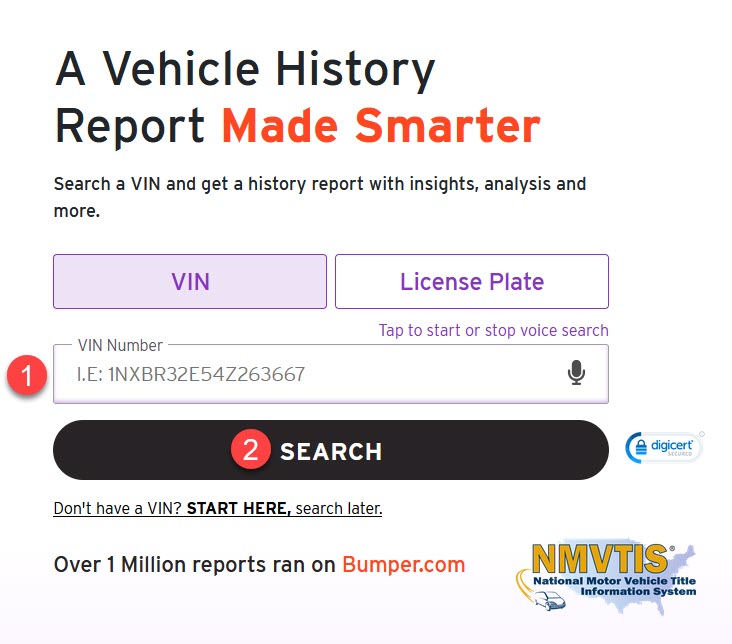
Then Bumper will check the VIN against the millions of records in its database.
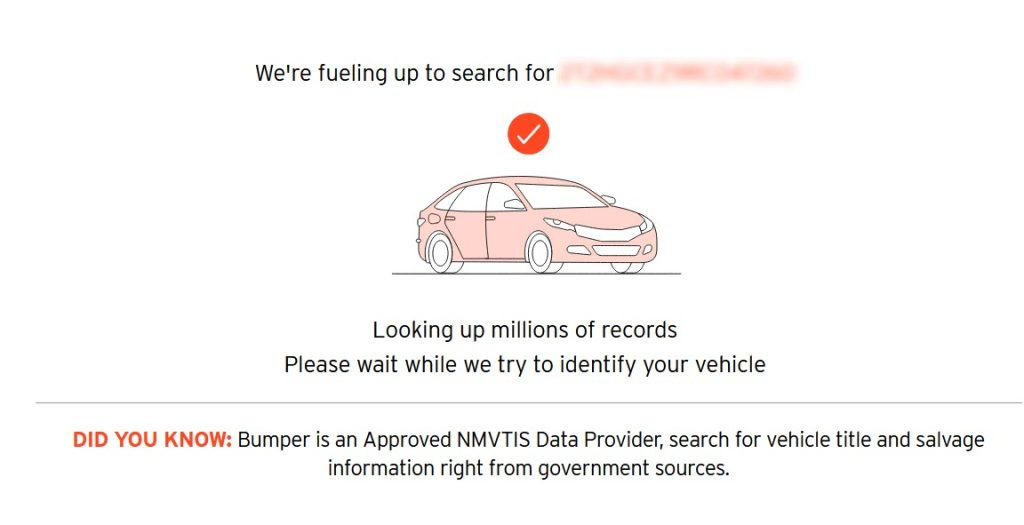
Once it locates a match, it will generate a report.
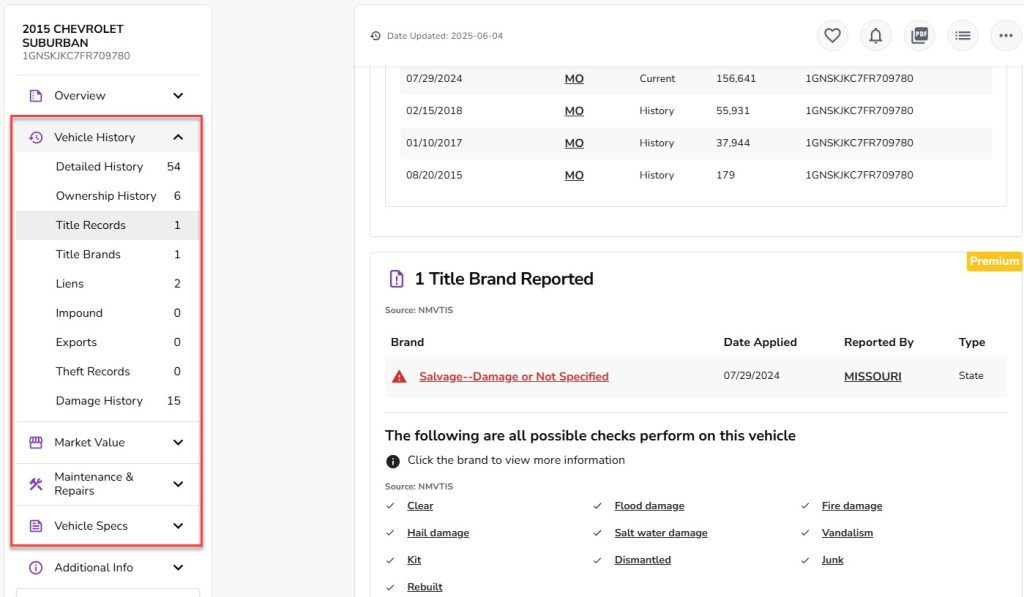
A Bumper report may unlock a detailed snapshot of a vehicle’s life on the road: functionality, previous owners, title history, accident history, maintenance records, mileage, market value, and a whole lot of other information that may be relevant to your buying or selling decision.
Read more: How to Read a Vehicle History Report
2. Carfax
Carfax is one of the most recognized names in the vehicle history industry. While it’s officially listed as an NMVTIS-approved data provider for commercial customers only, it also offers detailed VIN lookup reports directly to the public through its website.

Carfax stands out for its rich accident history, service records, and ownership timelines, thanks to exclusive partnerships with dealerships, repair shops, insurance carriers, and fleet services.
Pricing isn’t a strength for Carfax, though. Single reports start at $44.99, and even discounted packages or dealership subscription programs, ranging from $900 to $1,500 per month, can still be costly enough to deter many buyers. That’s why Carfax is often best used when you’re seriously considering a specific vehicle and want to do a final deep dive before making a purchase.

Read more: Where Do VIN Lookup Services Get Their Data – And How
What if my VIN is not 17 digits?
If your vehicle’s VIN isn’t exactly 17 characters, don’t worry. It doesn’t mean it’s invalid. In most cases, it just means that your car was manufactured before 1981, before VINs were standardized into the form we know today, which we are about to cover below.
Pre-1981 VINs were often shorter— typically ranging from 5 to 13 characters, though some stretched to 17. There was no universal format back then; each manufacturer used its own system. This meant VINs could vary a lot – not just in length and structure, but also in where they were placed on the vehicle. Also, because of this, two entirely different vehicles, even from different brands, might end up with the same number.
How to locate a shorter VIN
On older vehicles, VINs weren’t always placed in the same spot — location varied by manufacturer. Here’s where to look depending on the brand:
- Cadillac, Chevrolet, Pontiac & GM:
Look on the driver’s side door hinge pillar, under the front seats on the floorboards, or in the engine bay near the firewall. You may also find it near the steering column or on the left front body hinge pillar. - Ford, Lincoln & Mercury:
Often found on the driver’s side front door pillar or the engine-side of the firewall. Some models may also have it on the right front fender, above the upper suspension arm. - Dodge & Plymouth:
Typically located on the driver’s side front fender or on the radiator cross support near the upper cowl or firewall. - General spots across makes:
- On the dashboard, near the windshield on the driver’s side (visible from outside)
- Inside the driver’s side wheel well
- Under the steering column
- On the frame rails (driver’s or passenger’s side)
- On major components like the engine block (note: engines may have been swapped)
💡 Tip: Besides the VIN, some vehicles might carry related identifiers such as chassis numbers, serial numbers, trim tags, or axle stamps. These aren’t standardized like modern VINs, but they may still help confirm a car’s identity.
Last but not least, don’t forget to check your paperwork. This includes bills of sale, title, registration, insurance documents, or maintenance logs.
Pre-1981 VIN decoding & lookup
Decoding a pre-1981 VIN isn’t always plug-and-play. Each automaker used their own system, and you’ll likely need:
- Manufacturer-specific decoding guides
- Classic car forums or registries (e.g. DecodeThis)
- Help from car clubs or brand archives
Looking up the vehicle’s history is trickier, too. Most modern services like Carfax or AutoCheck won’t return anything for a pre-1981 VIN. That said, Bumper is one of the few that accepts non-standard VINs and can sometimes surface specs, title history, or auction records if the data exists.
💡 Tip: If decoding or looking up a vehicle’s past feels tricky, try running the VIN through a search engine combined with terms like “salvage,” “auction,” or “sale”, you might stumble on old listings, forum threads, or sales records.
VIN history: How VINs standardized over time
Ever wonder why every modern vehicle’s VIN is exactly 17 characters—and not more or less?
The journey to this standardized length wasn’t immediate. Back in 1954, the United States first introduced VINs—but there was no universal standard. Different manufacturers—and even different divisions within the same company—created their own unique numbering systems, often little more than simple serial numbers. This patchwork approach made it difficult to reliably identify vehicles across the market.
Things began to change in 1966, when the U.S. government mandated a 13-character VIN format. While this was a step forward, manufacturers still had the freedom to fill parts of the code as they pleased, so the system remained somewhat inconsistent.
In 1981, the National Highway Traffic Safety Administration (NHTSA) established the now-mandatory 17-character VIN format, which omits the letters I, O, and Q to prevent confusion and remains the standard for all vehicles sold in the U.S.
Worldwide adoption was rapid but gradual. For example, Volkswagen didn’t begin fully encoding detailed vehicle information until the mid-1990s, and some European brands started using the VIN check digit more extensively only in the 2010s.
Today, the VIN is far more than just a serial number—it’s a carefully crafted global language that tells a vehicle’s story, from the factory floor to its final destination.
Footnotes:
- You’ll often hear people say ‘VIN number’ — even though that’s technically redundant, since the ‘N’ already stands for ‘number.’ We’ll occasionally use the phrase too, simply because it’s so common in everyday searches.[↩]
- Includes passenger cars, motorcycles, trucks, buses, trailers, and other motor vehicles built for road use.[↩]
- VIN etching involves permanently engraving the Vehicle Identification Number onto the glass surfaces of a car, making it harder for thieves to sell parts or the vehicle itself without detection. This technology is widely used as a theft deterrent and helps law enforcement trace stolen vehicles.[↩]
- ISO 3779:2009, Road vehicles — Vehicle identification number (VIN) — Content and structure,
https://cdn.standards.iteh.ai/samples/52200/7d8a69aee84c4ad28231053f49f4966e/ISO-3779-2009.pdf [↩] - ISO 4030:1983, Road vehicles — Vehicle identification number (VIN) — Location and attachment, https://cdn.standards.iteh.ai/samples/9721/78dde4344d5640c4a7ec57947d771a93/ISO-4030-1983.pdf [↩]
- While highly reliable at catching typos or simple tampering, it isn’t foolproof against expertly forged VINs.[↩]




 View all of Enya Zhang's posts.
View all of Enya Zhang's posts.

